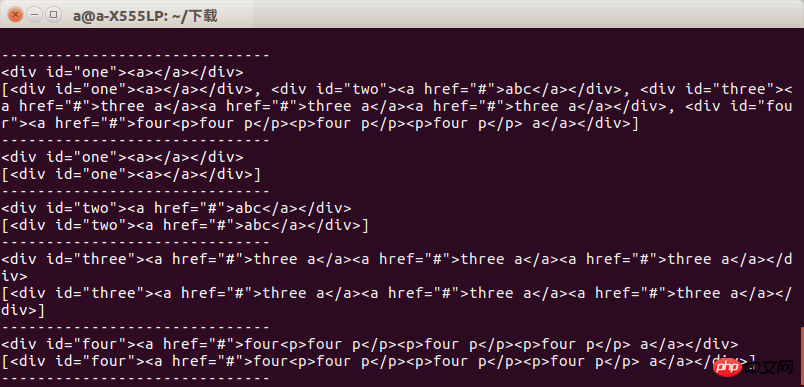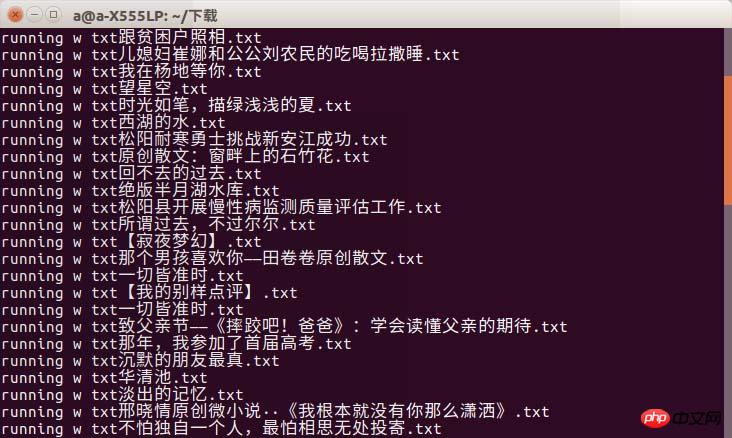Python crawling article example tutorial
This article mainly introduces you to the relevant information of using python to crawl prose network articles. The introduction in the article is very detailed and has certain reference and learning value for everyone. Friends who need it can take a look below.
This article mainly introduces to you the relevant content about python crawling prose network articles. It is shared for your reference and study. Let’s take a look at the detailed introduction:
The rendering is as follows:

Configure python 2.7
bs4 requests
Installation using pipsudo pip install bs4
##
sudo pip install requests
For example, we write a test.html to test the difference between find and find_all.
The content is:
<html> <head> </head> <body> <p id="one"><a></a></p> <p id="two"><a href="#" rel="external nofollow" rel="external nofollow" rel="external nofollow" rel="external nofollow" rel="external nofollow" >abc</a></p> <p id="three"><a href="#" rel="external nofollow" rel="external nofollow" rel="external nofollow" rel="external nofollow" rel="external nofollow" >three a</a><a href="#" rel="external nofollow" rel="external nofollow" rel="external nofollow" rel="external nofollow" rel="external nofollow" >three a</a><a href="#" rel="external nofollow" rel="external nofollow" rel="external nofollow" rel="external nofollow" rel="external nofollow" >three a</a></p> <p id="four"><a href="#" rel="external nofollow" rel="external nofollow" rel="external nofollow" rel="external nofollow" rel="external nofollow" >four<p>four p</p><p>four p</p><p>four p</p> a</a></p> </body> </html>
from bs4 import BeautifulSoup import lxml if __name__=='__main__': s = BeautifulSoup(open('test.html'),'lxml') print s.prettify() print "------------------------------" print s.find('p') print s.find_all('p') print "------------------------------" print s.find('p',id='one') print s.find_all('p',id='one') print "------------------------------" print s.find('p',id="two") print s.find_all('p',id="two") print "------------------------------" print s.find('p',id="three") print s.find_all('p',id="three") print "------------------------------" print s.find('p',id="four") print s.find_all('p',id="four") print "------------------------------"

def get_html():
url = "https://www.sanwen.net/"
two_html = ['sanwen','shige','zawen','suibi','rizhi','novel']
for doc in two_html:
i=1
if doc=='sanwen':
print "running sanwen -----------------------------"
if doc=='shige':
print "running shige ------------------------------"
if doc=='zawen':
print 'running zawen -------------------------------'
if doc=='suibi':
print 'running suibi -------------------------------'
if doc=='rizhi':
print 'running ruzhi -------------------------------'
if doc=='nove':
print 'running xiaoxiaoshuo -------------------------'
while(i<10):
par = {'p':i}
res = requests.get(url+doc+'/',params=par)
if res.status_code==200:
soup(res.text)
i+=ires.status_code that is not 200. The resulting problem is that the error will not be displayed, and the crawled content will have lost. Then I analyzed the web page of prose website and found that it was www.sanwen.net/rizhi/&p=1
def soup(html_text): s = BeautifulSoup(html_text,'lxml') link = s.find('p',class_='categorylist').find_all('li') for i in link: if i!=s.find('li',class_='page'): title = i.find_all('a')[1] author = i.find_all('a')[2].text url = title.attrs['href'] sign = re.compile(r'(//)|/') match = sign.search(title.text) file_name = title.text if match: file_name = sign.sub('a',str(title.text))
def get_content(url): res = requests.get('https://www.sanwen.net'+url) if res.status_code==200: soup = BeautifulSoup(res.text,'lxml') contents = soup.find('p',class_='content').find_all('p') content = '' for i in contents: content+=i.text+'\n' return content
f = open(file_name+'.txt','w') print 'running w txt'+file_name+'.txt' f.write(title.text+'\n') f.write(author+'\n') content=get_content(url) f.write(content) f.close()
f = open(file_name+'.txt','w') print 'running w txt'+file_name+'.txt' f.write(title.text+'\n') f.write(author+'\n') content=get_content(url) f.write(content) f.close()

The above is the detailed content of Python crawling article example tutorial. For more information, please follow other related articles on the PHP Chinese website!

Hot AI Tools

Undresser.AI Undress
AI-powered app for creating realistic nude photos

AI Clothes Remover
Online AI tool for removing clothes from photos.

Undress AI Tool
Undress images for free

Clothoff.io
AI clothes remover

Video Face Swap
Swap faces in any video effortlessly with our completely free AI face swap tool!

Hot Article

Hot Tools

Notepad++7.3.1
Easy-to-use and free code editor

SublimeText3 Chinese version
Chinese version, very easy to use

Zend Studio 13.0.1
Powerful PHP integrated development environment

Dreamweaver CS6
Visual web development tools

SublimeText3 Mac version
God-level code editing software (SublimeText3)

Hot Topics
 1662
1662
 14
14
 1419
1419
 52
52
 1313
1313
 25
25
 1262
1262
 29
29
 1235
1235
 24
24
 PHP and Python: Different Paradigms Explained
Apr 18, 2025 am 12:26 AM
PHP and Python: Different Paradigms Explained
Apr 18, 2025 am 12:26 AM
PHP is mainly procedural programming, but also supports object-oriented programming (OOP); Python supports a variety of paradigms, including OOP, functional and procedural programming. PHP is suitable for web development, and Python is suitable for a variety of applications such as data analysis and machine learning.
 Choosing Between PHP and Python: A Guide
Apr 18, 2025 am 12:24 AM
Choosing Between PHP and Python: A Guide
Apr 18, 2025 am 12:24 AM
PHP is suitable for web development and rapid prototyping, and Python is suitable for data science and machine learning. 1.PHP is used for dynamic web development, with simple syntax and suitable for rapid development. 2. Python has concise syntax, is suitable for multiple fields, and has a strong library ecosystem.
 PHP and Python: A Deep Dive into Their History
Apr 18, 2025 am 12:25 AM
PHP and Python: A Deep Dive into Their History
Apr 18, 2025 am 12:25 AM
PHP originated in 1994 and was developed by RasmusLerdorf. It was originally used to track website visitors and gradually evolved into a server-side scripting language and was widely used in web development. Python was developed by Guidovan Rossum in the late 1980s and was first released in 1991. It emphasizes code readability and simplicity, and is suitable for scientific computing, data analysis and other fields.
 Python vs. JavaScript: The Learning Curve and Ease of Use
Apr 16, 2025 am 12:12 AM
Python vs. JavaScript: The Learning Curve and Ease of Use
Apr 16, 2025 am 12:12 AM
Python is more suitable for beginners, with a smooth learning curve and concise syntax; JavaScript is suitable for front-end development, with a steep learning curve and flexible syntax. 1. Python syntax is intuitive and suitable for data science and back-end development. 2. JavaScript is flexible and widely used in front-end and server-side programming.
 How to run sublime code python
Apr 16, 2025 am 08:48 AM
How to run sublime code python
Apr 16, 2025 am 08:48 AM
To run Python code in Sublime Text, you need to install the Python plug-in first, then create a .py file and write the code, and finally press Ctrl B to run the code, and the output will be displayed in the console.
 Where to write code in vscode
Apr 15, 2025 pm 09:54 PM
Where to write code in vscode
Apr 15, 2025 pm 09:54 PM
Writing code in Visual Studio Code (VSCode) is simple and easy to use. Just install VSCode, create a project, select a language, create a file, write code, save and run it. The advantages of VSCode include cross-platform, free and open source, powerful features, rich extensions, and lightweight and fast.
 Can visual studio code be used in python
Apr 15, 2025 pm 08:18 PM
Can visual studio code be used in python
Apr 15, 2025 pm 08:18 PM
VS Code can be used to write Python and provides many features that make it an ideal tool for developing Python applications. It allows users to: install Python extensions to get functions such as code completion, syntax highlighting, and debugging. Use the debugger to track code step by step, find and fix errors. Integrate Git for version control. Use code formatting tools to maintain code consistency. Use the Linting tool to spot potential problems ahead of time.
 How to run python with notepad
Apr 16, 2025 pm 07:33 PM
How to run python with notepad
Apr 16, 2025 pm 07:33 PM
Running Python code in Notepad requires the Python executable and NppExec plug-in to be installed. After installing Python and adding PATH to it, configure the command "python" and the parameter "{CURRENT_DIRECTORY}{FILE_NAME}" in the NppExec plug-in to run Python code in Notepad through the shortcut key "F6".




